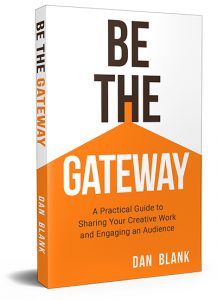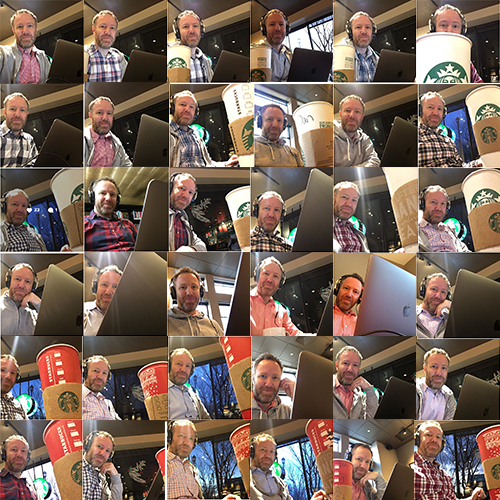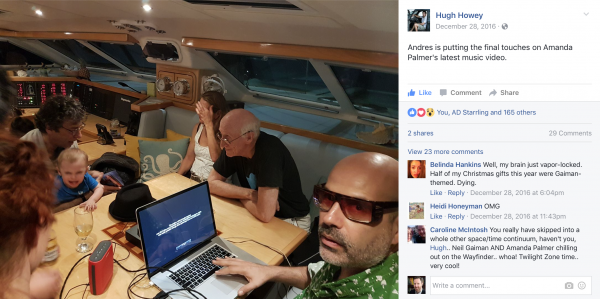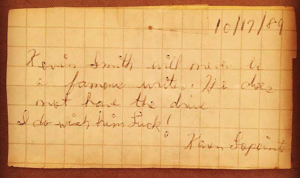If you have a creative vision that you hope finds an audience, I encourage you to identify collaborators that you can work with. Too often, writers and other creative professionals struggle with their craft alone. The reality: collaborators are an essential part of the creative process, and how inspired work reaches the world.
Today I want to share a few examples of what this may look like, and ways that you can seek out collaborators regardless of where you are, and what you work on.
Collaborators and Craft
Last week I mentioned that I’m releasing my first book. When I reflect on the process, it has been highly collaborative at every stage. Let me take you behind the scenes:
The topic of the book came out of a collaboration I have in a mastermind group I run. This is a small group of creative professionals who help support each others work. I record an original video for the group each day, offering my advice to help them stay on track with their creative work, and ensure it reaches an audience.
One day I shared a video called “Be the Gateway.” It was a concept I crafted live during the video, and the feedback from the group was amazing. Their reactions helped me expand it into a blog post. I received even more feedback on that blog, so I decided to expand it into a book.
This is where collaboration is helpful in the creative process. I knew it would be a worthwhile topic to explore because my audience already showed me it was.
In vetting this topic further, I talked to my friend Jennie Nash. In those conversations she helped give really good feedback on how the concept could help writers, and it gave me even more confidence and direction.
As I began working on the book, she helped me navigate a lot of questions, and put a structure around the process.
My team here at WeGrowMedia got involved, helping to edit and set the strategy for publishing.
As the book began coming together, I formed a small launch team of people who would provide feedback on it. At times they were beta readers, reading entire sections of the book and providing feedback and edits. Other times they provided feedback on specific publishing questions, including helping me set the price for the book.
Even now as I prepare for publication, I am speaking to dozens of others who will share this work with their audience.
In addition to these people, I’ve hired a copyeditor, cover designer, and layout designer. Plus, lots of people have helped with advice, including the very generous Eric Van Der Hope.
My name is on the cover, but every part of this was a collaborative process.
The Daily Practice of Collaboration
I mentioned my mastermind group earlier, and the work we do there is focused on the daily practice of creative work. Here we set weekly intentions around our creative goals; we encourage each other to develop clarity of focus and good habits; and we help each other get back on track when distraction inevitably gets the better of us.
Throughout my life I have been a writer, an artist, a musician, a painter, a sculptor, and many other things. At each phase, I was always surrounded by collaborators. Some were passive — other people in the community that I engaged with, but many others were active. Those who helps shape the work and how it finds an audience.
So many creative professionals I meet are overwhelmed with their many responsibilities at home, with their career, and with their creative projects. Involving collaborators on a daily or weekly basis radically shifts their ability to stay on track.
There are so many apps and processes nowadays that promise to help you manage your busy life. What I have found is that collaborators — other people — are the best way to not just find success, but also having the process feel meaningful and fulfilling.
Collaborators and Connection
In the past few years I have gotten more involved in my local arts community. I volunteered at the Morristown Festival of Books, I did small things to support my friend Barb launch her bookstore, and I was one of the founders of the Madison Storytellers Festival.
Each of these things would not have been possible without a wide range of collaborators.
Success in sharing the arts or in growing a business all relies on collaborators. If you want to seek out collaborators, here are a few ideas:
- Seek out others in your community who work on creative projects. If you are a romance author, you do not need to seek out other romance authors. I have found incredible value by collaborating with people across disciplines. If you had coffee once per week with a local artist, crafter, musician, or entrepreneur, they would still help keep you on track and inspired.
- Develop colleagues virtually. In the 6+ years I have run WeGrowMedia, and the 10+ years I have had a newsletter and blog, I have develop countless connections to people who live nowhere near me. In fact, most of the people I mentioned above who have assisted with my book live all around the world. Reach out to people via email and social media to strengthen loose connections.
- Develop a short-term project with a collaborator to exercise that muscle. For instance, when we developed the Madison Storytellers Festival, none of us did so thinking we were committing to some annual event. We figured we had nothing to lose by spending a few months trying this new idea. The energy that has been created allowed us to make a decision later on that it should be an annual event. If you are collaborator-curious, then place boundaries on a small project, and try it out.
Collaborate Now
Recently, my wife volunteered to run a workshop for local first graders on the artist Keith Haring. She spent weeks preparing and each student was able to create their own version of a Haring-inspired figure.
Here is a classic Keith Haring piece:
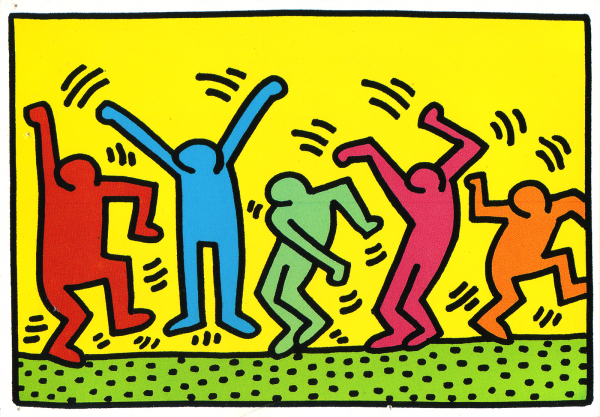
And here is a sampling of some of the pieces the first graders created:

Watching this process, I spent some time researching Keith’s life. I was astounded to learn he died at the age of 31. Perhaps I knew this earlier in my life, when 31 seemed like a “ripe old age.” But now, at 43, it seems impossibly young. All I can consider is potential that died with him.
Yet, he saw it otherwise: he saw this limit as one that fueled him. From Wikipedia:
Despite all the fear that led up to [his AIDS] diagnosis, in some ways Haring found his impending death liberating. It pushed him to produce more work as quickly as possible.
In a 1989 interview with Rolling Stone magazine, Haring stated, “That’s the point that I am at now, not knowing where it stops but knowing how important it is to do it now. The whole thing is getting more articulate. In a way it’s really liberating.”
Critics have recognized this about Haring’s works – particularly his later works – as well. “Haring’s way of living life – liberated and with death in mind at a young age – allowed him to pull himself away from his diagnosis,” Blinderman writes. “A year after his original diagnosis he was producing radiant paintings of birth and life.”
The introduction to the compilation of Haring’s journals sings the same song: “Haring accepts his death. For in his art he found the key to transform desire, the force that killed him, into a flowering elegance that will live beyond his time.
Haring created his work in public. He rose to fame by sharing his work in the streets and subways of New York City. Collaboration was an inherent part of his work because it was being engaged with by the audience even as it was created. People would watch him craft his art in public.
He opened a store in New York City in 1986 called Pop Shop, where “Posters could be had for a dollar and “Radiant Baby” buttons for fifty cents.” His store made his work accessible to the masses in ways that others artists of his fame would not.
Keith forged his own path to collaboration that helped fuel his art, not hinder it. What’s yours? How can you make your creative process and how your work is shared more collaborative?
Further reading: here are a few posts I have published about the value of collaboration.
- The secret to growing an audience? Collaboration.
- Collaboration and creative work
- Two Words to Define Your Career: Custom and Collaborative
Thanks.
-Dan

